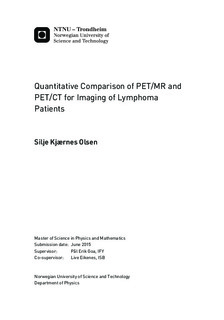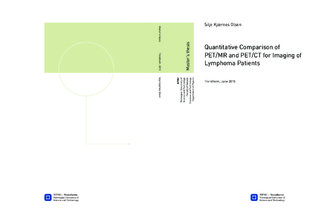| dc.description.abstract | Positron emission tomography/computed tomography (PET/CT), a multimodality imaging tool, is today the golden standard in diagnosis, staging and response monitoring of lymphoma patients, while it is investigated if positron emission tomography/magnetic resonance (PET/MR) is superior to PET/CT and should be the gold standard in imaging of lymphoma patients in the future.
In this study, PET/MR and PET/CT have been quantitatively compared for imaging of lymphoma patients, by the semi-quantitative measure standardized uptake value (SUV) from the PET images and the apparent diffusion coefficient (ADC) from diffusion-weighted MR images. The correlation between SUV from PET/MR and PET/CT and between SUV and ADC was evaluated, as well as the PET image quality, measured by the coefficient of variance (COV).
Fourteen lymphoma patients were included, and underwent a PET/CT examination followed by a PET/MR examination. Regions of interest (ROIs) were made in the same forty-two lesions in the PET images of PET/MR and PET/CT for the SUV analysis. Seven lesions were included in the ADC analysis, where six different shaped ROIs were drawn in each lesion, to see if the shape influenced the result. COV was measured in ROIs in the liver of each patient in the PET images.
A strong correlation was found between SUV from PET/MR and PET/CT, and the difference in SUV was not statistically significantly. No correlation was found between ADC and SUV, in any of the different shaped ROIs for ADC measurements. COV was significantly increased in PET/MR, compared to PET/CT, indicating a reduced PET image quality for PET/MR.
The SUV measurements from PET/MR are similar to those from PET/CT, hence the two modalities are quantitatively comparable. Qualitative studies must also be performed to determine if PET/MR is superior to PET/CT for imaging of lymphoma patients. More lesions should be included in the ADC analysis, to evaluate the relationship between SUV and ADC. Further work should be performed to find the cause of the reduced image quality of PET images obtained from PET/MR. | |

